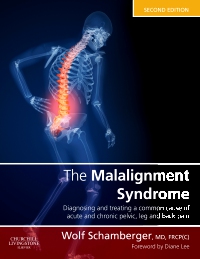
The Malalignment Syndrome, 2nd Edition
Hardcover

Now $95.40
Lack of appreciation and knowledge of the malalignment syndrome often leads to a failure to notice the possible aetiological or predisposing factors contributing to many musculoskeletal problems. Recognition of the syndrome by physicians, chiropractors, osteopaths, podiatrists, physiotherapists, kinesiologists, sports trainers and others dealing with patients and athletes (including equine) can help them implement appropriate treatment and training to correct the malalignment and actually prevent the initial occurrence of symptoms.
Now in its second edition, The Malalignment Syndrome has established itself as a trusty one-stop reference providing a detailed description of this syndrome and how it can be identified and treated. It concentrates on the trunk, pelvis, spine, sacroiliac joint and legs, incorporating anatomy, biomechanics, stability issues, possible causes, examination and diagnostic techniques as well as a comprehensive treatment approach. Emphasis is also placed on the participation of the patient/athlete in the day-to day treatment process to achieve long-term results.
-
- Evidence-based practical advice and guidance
- Multidisciplinary in approach
- Highly illustrated with photographs, diagrams and anatomical models
- Recognizes the importance of prevention as well as treatment
- Summary and case boxes
-
- Over 100 new illustrations
- Additional examination techniques to facilitate diagnosis
- Extensively rewritten for easier reading
- Contributions by David Lane (Chapter 6: Horses, Saddles and Riders), Sarah Stevens and Karina Steinberg (Chapter 8: Treatment: The Manual Therapy Modes)
- Focuses on diagnosis/treatment of malalignment-related pelvic, leg and back pain
-
ForewordAcknowledgementsIntroduction 2012Introduction 2002 (1st edition)
Ch 1. The malalignment syndrome: A synopsis
Ch 2. Common presentations and diagnostic techniques
Ch 3. The Malalignment Syndrome
Ch 4. The malalignment syndrome: Related pain phenomena and the implications for medicine
Ch 5. Clinical correlations in sports
Ch 6. Horses, saddles and ridersDavid Lane and Lauren Fraser
Ch 7. A comprehensive treatment approach
Ch 8. Treatment: Manual therapy modesSarah Stevens and Karina Steinberg
Ch 9. Conclusion
Appendices1. Sacroiliac joint ‘rotational malalignment’2. Sacroiliac joint ’upslip’ (right side)3. Asymmetry of lower extremity ranges of motion4. Asymmetry of lower extremity muscle strength5. Clinical correlations specific to running6. Clinical findings: Anatomical (true) long right leg7. Combination of asymmetries (1st case presentation)8. Combination of asymmetries (2nd case presentation)9. ‘The thoracolumbar syndrome’10. Clinical correlations to non-specific sports11. Clinical correlations to specific sports12. Factors contributing to recurrence of injuries13. Causes of recurrent malalignment
GlossaryReferences

 as described in our
as described in our 